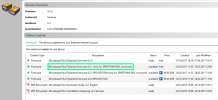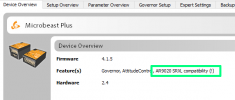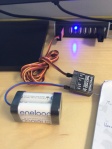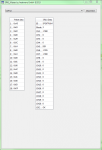Empfänger und Verwendung mit dem MICROBEAST / MICROBEAST PLUS
SPEKTRUM Empfänger mit SRXL Signalausgabe
Ich verwende ein MICROBEAST PLUS mit Firmware 3.2.0 (oder höher) und möchte den SRXL Ausgang meines Spektrum Empfängers nutzen. Obwohl im Empfänger Einstellmenu der Empfängertyp bei Einstellpunkt A auf "SRXL" gestellt wurde, werden keine Empfängersignale erkannt. Die Status LED bei Einstellpunkt B bleibt rot.
Leider entspricht das SRXL Protokoll einiger SPEKTRUM Empfänger nicht der Vorgabe des SRXL Standards (z. B. AR9020, AR8010T, AR9030T, AR9320T). Wir bieten daher eine speziell für diese Empfänger angepasste MICROBEAST PLUS Firmware an, die das Signal dekodieren kann. Diese Firmware kann über die Updatefunktion von StudioX bezogen werden. Sie ist an dem Zusatz "only for SPEKTRUM SRXL receivers!" zu erkennen.
Bitte beachten: Diese Firmware kann nicht mit anderen Empfängern verwendet werden und es kann kein anderer Empfängertyp außer SRXL ausgewählt werden. Einstellpunkt A im Empfänger Einstellmenü wird automatisch übersprungen!
In Hinblick auf die restliche Funktionalität besteht ansonsten keinerlei Unterschied zu der "normalen" MICROBEAST PLUS Firmware. Ein Wechsel zwischen den verschiedenen Firmware Versionen ist jederzeit möglich, ohne dass bestehende Einstellungen neu vorgenommen werden müssen.
Red Status LED at menu point B shows that the system is not receiving valid channel data or no data at all. This can have several reasons:
- Check that you've selected the correct receiver type / transmission protocol at Receiver menu point A.
- Make sure the receiver's output is connected properly to CH5/DI1 input of MICROBEAST / MICROBEAST PLUS.
- Make sure the transmitter is bound to the receiver and the receiver is receiving control signals from the transmitter. Keep some distance between receiver and transmitter.
- Some Spektrum SRXL receivers require a special firmware (MICROBEAST PLUS only) which can decode the signals of these receivers. These receivers use a very unique coding which is not conform to the SRXL standards.
When using a SRXL receiver we offer a free software to download that allows to connect your receiver to the computer with the USB2SYS interface adapter. With this SRXLViewer software you can make the output of your receiver visible and analyze the data output (if there is any), so you can find out why MICROBEAST does not accept the incoming signal. At the moment this software is only available for Microsoft Windows, you can get it here (click).
Just unzip the folder to somewhere on the Harddisk and start the .exe file (or it even should run from winrar, winzip, whatever, when opening it there).
| Connect the receiver's SRXL port directly to the USB2SYS interface. The receiver needs some receiver battery or similar power source. | In the software select the COM port of the interface and click connect. Then you should see data output like this. |
When the CRC is not correct or the data output is delayed or interrupted probably there is something not correct with the signal coming from your receiver. When there is no data output please contact the manufacturer of your radio system.
MICROBEAST / MICROBEAST PLUS with single SPEKTRUM remote satellite on large helis
Why is using a single SPEKTRUM remote satellite only recommended for helis equal or smaller than 450 size?
We say it is not safe to use a single remote satellite on anything bigger than TRex 450 size as the chassis on larger helis may hide the satellite in different flight situations. So you will loose direct sight between TX and RX more easily on larger helis. Additionally with large helis you fly further away than with small helis, so this doubles the risk of loosing the RF link when the satelite antenna is hidden. Using an EU Version of the SPEKTRUM TX even more it is very likely the RF link may get disturbed in such situations as these radios do not have so much RF power output. If using an US version of the SPEKTRUM radio with 300mW output power this can be different though. But also here we can't give a general rule, as the quality of RF link depends on many other factors like such mentioned above (Where is the satellite placed? Is direct sight to the TX in any flight condition guaranteed? How far do you fly away? Are there obstacles in your flying field like tress or houses? ...). So it's hard to give a definitive limit and we only recommend to use this setup on small helis as this can be considered as safe application.



